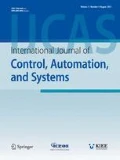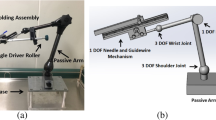Abstract
This paper proposes a new ultrasonography guided arterial puncturing and guidewire insertion mechanism. In conventional arterial puncturing, a physician holds an ultrasound probe in one hand and a needle in the other. Due to the prolong holding of ultrasound probe in hand, physicians and sonographers face musculoskeletal disorders. Also the contact force exerted by the hand of the physician is variable. The purpose of this study is to develop a passive device that will not only hold the ultrasound probe, but also performs needle and guidewire insertion with precision and accuracy. To test the effectiveness of the device, animal experimentation has been performed. This device showed 100% successful insertion rate and the operating time has been reduced from 4.5 minutes to 3.8 minutes. The proposed ultrasound probe holder exerts a stable contact force on the skin of the patient which helps to provide a stable image.
Similar content being viewed by others
References
J. Village and C. Trask, “Ergonomic analysis of postural and muscular loads to diagnostic sonographers,” International Journal of Industrial Ergonomics, vol. 37, no. 9–10, pp. 781–789, 2007.
A. Schoenfeld, J. Goverman, D. M. Weiss, and I. Meizner, “Transducer user syndrome: an occupational hazard of the ultrasonographer,” European Journal of Ultrasound, vol. 10, no. 1, pp. 41–45, 1999.
A. M. Priester, S. Natarajan, and M. O. Culjat, “Robotic ultrasound systems in medicine,” IEEE Transactions on Ultrasonics, Ferroelectrics, and Frequency Control, vol. 60, no. 3, pp. 507–523, 2013.
J. Esteban, W. Simson, S. R. Witzig, A. Rienmüller, S. Virga, B. Frisch, O. Zettinig, D. Sakara, Y.-M. Ryang, N. Navab, and C. Hennersperger, “Robotic ultrasound-guided facet joint insertion,” International Journal of Computer Assisted Radiology and Surgery, vol. 13, no. 6, pp. 895–904, 2018.
A. S. B. Mustafa, T. Ishii, Y. Matsunaga, R. Nakadate, H. Ishii, K. Ogawa, A. Saito, M. Sugawara, K. Niki, and A. Takanishi, “Development of robotic system for autonomous liver screening using ultrasound scanning device,” Proc. of IEEE International Conference on Robotics and Biomimetics, pp. 804–809, 2013.
A. Vilchis, J. Troccaz, P. Cinquin, K. Masuda, and F. Pellissier, “A new robot architecture for tele-echography,” IEEE Transactions on Robotics and Automation, vol. 19, no. 5, pp. 922–926, 2003.
K. Mathiassen, J. E. Fjellin, K. Glette, P. K. Hol, and O. J. Elle, “An ultrasound robotic system using the commercial robot UR5,” Frontiers in Robotics and AI, vol. 3, p. 1, 2016.
J. A. Cadeddu, D. Stoianovici, R. N. Chen, R. G. Moore, and L. R. Kavoussi, “Stereotactic mechanical percutaneous renal access,” Journal of Endourology, vol. 12, no. 2, pp. 121–125, 1998.
J. Hong, T. Dohi, M. Hashizume, K. Konishi, and N. Hata, “An ultrasound-driven needle-insertion robot for percutaneous cholecystostomy,” Physics in Medicine & Biology, vol. 49, no. 3, p. 441, 2004.
J. Kettenbach, G. Kronreif, M. Figl, M. Fürst, W. Birkfellner, R. Hanel, H. Bergmann, “Robot-assisted biopsy using ultrasound guidance: initial results from in vitro tests,” European radiology, vol. 15, no. 4, pp. 765–771, 2005.
R. Nakadate, J. Solis, A. Takanishi, M. Sugawara, K. Niki, and E. Minagawa, “Development of the ultrasound probe holding robot WTA-1RII and an automated scanning algorithm based on ultrasound image feedback,” ROMANSY18 Robot Design, Dynamics and Control, Springer, pp. 359–366, 2010.
N. Smith-Guerin, L. Al Bassit, G. Poisson, C. Delgorge, P. Arbeille, and P. Vieyres, “Clinical validation of a mobile patient-expert tele-echography system using ISDN lines,” Proc. of the 4th International IEEE EMBS Special Topic Conference on Information Technology Applications in Biomedicine, pp. 23–26, 2003.
M. W. Gilbertson and B. W. Anthony, “An ergonomic, instrumented ultrasound probe for 6-axis force/torque measurement,” Proc. of the 35th Annual IEEE International Conference on Engineering in Medicine and Biology Society (EMBC), pp. 140–143, 2013.
M. W. Gilbertson and B. W. Anthony, “Force and position control system for freehand ultrasound,” IEEE Transactions on Robotics, vol. 31, no. 4, pp. 835–849, 2015.
M. W. Gilbertson and B. W. Anthony, “Ergonomic control strategies for a handheld force-controlled ultrasound probe,” PRoc. of IEEE/RSJ International Conference on Intelligent Robots and Systems (IROS), pp. 1284–1291, 2012.
O. Salden, W. van Everdingen, R. Spee, P. Doevendans, and M. Cramer, “How I do it: feasibility of a new ultrasound probe fixator to facilitate high quality stress echocardiography,” Cardiovascular Ultrasound, vol. 16, no. 1, p. 6, 2018.
S. M. Yoon, W. J. Kim, and M. C. Lee, “Design of bilateral control for force feedback in surgical robot,” International Journal of Control, Automation and Systems, vol. 13, no. 4, pp. 916–925, 2015.
S. Y. Ko, W.-J. Lee, and D.-S. Kwon, “Intelligent interaction based on a surgery task model for a surgical assistant robot: Awareness of current surgical stages based on a surgical procedure model,” International Journal of Control, Automation and Systems, vol. 8, no. 4, pp. 782–792, 2010.
Author information
Authors and Affiliations
Corresponding author
Additional information
Publisher’s Note Springer Nature remains neutral with regard to jurisdictional claims in published maps and institutional affiliations.
Recommended by Guest Editors Doo Yong Lee (KAIST) and Jaesoon Choi (Asan Medical Center). This work was supported by the Technology Innovation Program (or Industrial Strategic Technology Development Program-Artificial intelligence bio-robot medical convergence project) (20001257, Artificial intelligence algorithm based vascular intervention robot system for reducing radiation exposure and achieving 0.5 mm accuracy) funded by the Ministry of Trade, Industry & Energy (MOTIE, Korea), the Ministry of Health & Welfare (MOHW), Ministry of Science and ICT (MSIT), Korea Evaluation Institute of Industrial Technology (KEIT), supported by the Technology Innovation Program (10052980, Development of microrobotic system for surgical treatment of chronic total occlusion) funded by the Ministry of Trade, Industry & Energy, Korea, and supported by the BK21 Plus Program funded by National Research Foundation of Korea (NRF).
Muhammad Umair Ahmad Khan received his B.Sc. and M.S. degrees from University of Engineering & Technology Lahore, Pakistan. He is currently pursuing his Ph.D. degree in Mechatronics Engineering from Hanyang University, Korea. His research interests include robot mechanics with application to surgical robotic systems, and radiation protecton.
Byung-Ju Yi received his B.S. degree from Hanyang University, Seoul, Korea, in 1984, and his M.S. and Ph.D. degrees I from University of Texas at Austin (UT), I TX, USA, in 1986 and 1991, respectively, I in mechanical engineering. He served as a I Postdoctoral Fellow in the Robotics Group at UT and worked for the Department of Mechanical and Control Engineering, Korea Institute of Technology and Education, Chungnam, Korea. Since 1995, He has been a Professor at the Department of Electronic Systems Engineering, Hanyang University, Ansan, Korea. His research interests include robot mechanics with application to surgical robotic systems and ubiquitous sensor network-based robotics.
Rights and permissions
About this article
Cite this article
Khan, M.U.A., Yi, BJ. Design and Clinical Test of a Passive Ultrasound Probe Holder Mechanism for Arterial Puncturing. Int. J. Control Autom. Syst. 18, 29–37 (2020). https://doi.org/10.1007/s12555-019-0233-z
Received:
Revised:
Accepted:
Published:
Issue Date:
DOI: https://doi.org/10.1007/s12555-019-0233-z




